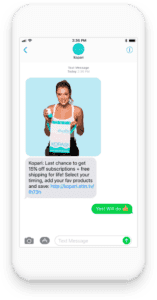Text messages cut through the clutter, says Shannon Murphy, customer retention manager at cosmetics retailer Kopari.
Kopari, which sells organic coconut-based beauty products, launched its e-commerce site KopariBeauty.com at the end of 2015. Kopari also sells its products at several retail stores and websites including Sephora USA Inc. (No. 136 in the Internet Retailer 2017 Top 500), Anthropologie and Nordstrom Inc. (No. 17). About 70% of Kopari’s sales stem from its website, and the retailer’s total sales grew 160% in 2017 over 2016, although Murphy declined to give specifics.
In the summer of 2017, Kopari knew it was relying too heavily on email as a marketing channel, Murphy says. The retailer decided that because the majority of its shoppers were smartphone shoppers—more than 70% of consumers visit KopariBeauty.com on a smartphone and 53% of the retailer’s sales are via a smartphone—that it made sense to market to these shoppers in a mobile way.
In October 2017, the retailer launched an SMS marketing program. In just four months, more than 10,000 shoppers have signed up to receive Kopari text messages, and SMS sign-ups have increased 65% month over month each month , Murphy says.
Such a large response surprised the organic coconut products retailer, which didn’t have any specific revenue goals tied to the program at launch. But it’s clear that the channel is working. Kopari attributes 14% of its website revenue in January to text messaging, she says, based on how many consumers who received and tapped on a text message and then made a purchase. Plus, smartphone sales have increased to now 60% of the retailer’s e-commerce sales, which Kopari in part attributes to the new SMS marketing channel, she says.
 Kopari sends roughly one message a week or about three to four a month, typically about product launches, sale items, product education, its auto replenishment service and its refer-a-friend contest. “As long as you provide value in the message and are not overdoing it,” Murphy says about balancing text cadence and bombarding shoppers with too many messages.
Kopari sends roughly one message a week or about three to four a month, typically about product launches, sale items, product education, its auto replenishment service and its refer-a-friend contest. “As long as you provide value in the message and are not overdoing it,” Murphy says about balancing text cadence and bombarding shoppers with too many messages.
The texts have a 38% click-through rate, which is the highest of any other marketing channel, Murphy says. This also doesn’t account for the shoppers who open the text message but don’t click through to the website, she adds.
“In general, people are on their phones—they are on their phones all the time,” Murphy says. “You open a text message and you click through to it when you are walking down the street. You can still do that with an email, but people are just used to opening and responding to texts.”
Plus, the email space is crowded, Murphy says. When Google’s email service Gmail made its update to filter promotional emails into a new tab in 2013, that hurt many retailers’ open rates, and now there is a lot of “noise” in a shopper’s inbox, Murphy says. Text messages cut through all of that, she says, and “customers aren’t getting as many text messages from brands,” Murphy says.
SMS and email are among the retailer’s top communication channels with the biggest return on investment, she says. Kopari used mobile messaging vendor Attentive Mobile Inc. for its text marketing program. Attentive charges between $200 and $1,000 per month, depending on the program features, says Murphy, without revealing more. Although, the return on the investment is well worth the cost, she says.
Kopari added a widget to its mobile site that advertises 10% off if shoppers sign up for the text program. If a shopper taps on it, her default messaging app opens with Kopari’s message pre-populated and a message populated in the text field to sign up for the program.
At first, Kopari was afraid the text program would interfere with its email sign-up program, which also offers 10% off, however, email is still growing its opt-ins as well, Murphy says.
 In January, Kopari surveyed its loyalty program members, and 25% of them said they preferred SMS as their form of communication from the brand, says Megan Bush, chief digital officer at Kopari. In the second quarter of this year, the retailer will add the text program sign-up widget to its desktop website, Murphy says. Next up, Kopari wants to personalize its text message program and segment the list like it does with email marketing campaigns, Murphy says.
In January, Kopari surveyed its loyalty program members, and 25% of them said they preferred SMS as their form of communication from the brand, says Megan Bush, chief digital officer at Kopari. In the second quarter of this year, the retailer will add the text program sign-up widget to its desktop website, Murphy says. Next up, Kopari wants to personalize its text message program and segment the list like it does with email marketing campaigns, Murphy says.
“SMS fits in with who our customers are,” Bush says. “We know our customer is on her phone. It wasn’t an issue of getting them on the mobile site. It was us being there and communicating with them.”
Since Kopari Beauty launched, the retailer has stuck to a fun, casual and conversational tone of voice when talking with shoppers on its website, social media and in marketing messages, which “struck a nerve,” Bush says. For example, the retailer finds that shoppers are engaged and likely to respond to Kopari if the retailer talks to shoppers like talking to a friend.
The retailer also is active on social media, especially on Facebook and Instagram. Kopari has 101,000 followers on Instagram and 163,000 likes on Facebook.
When Kopari first launched, the retailer gained valuable insights from interacting with consumers on social media. For example, the retailer learned the different ways shoppers were using its multi-use products as some of its products can be used on a shopper’s hair, body or legs. Also, the retailer collected feedback on its lotion packages that not enough lotion came out with each pump, and so Kopari switched its packaging based on this feedback.
Because of the casual tone and the retailer’s focus on social media, many of Kopari’s shoppers’ fall into the millennial age range of consumers aged 20-37. More than 50% of desktop traffic to KopariBeauty.com is from consumers ages 18-34, according to SimilarWeb data between November 2017-January 2018. Although, the fun tone of voice also resonates with women in their 30s and 40s as well, Bush says.
“Building our channel and building the brand on social lends itself to more younger demographics,” Bush says.
Favorite